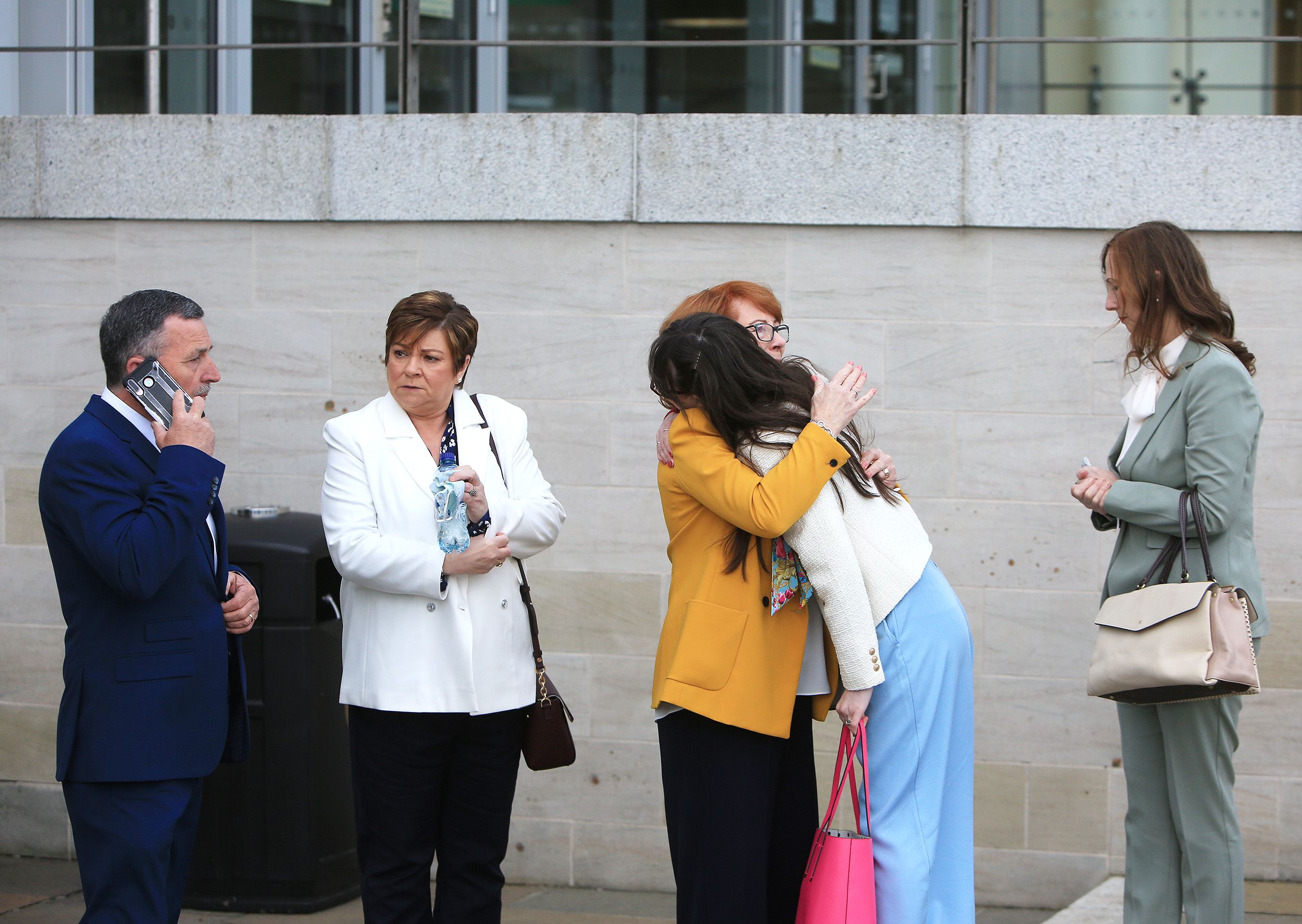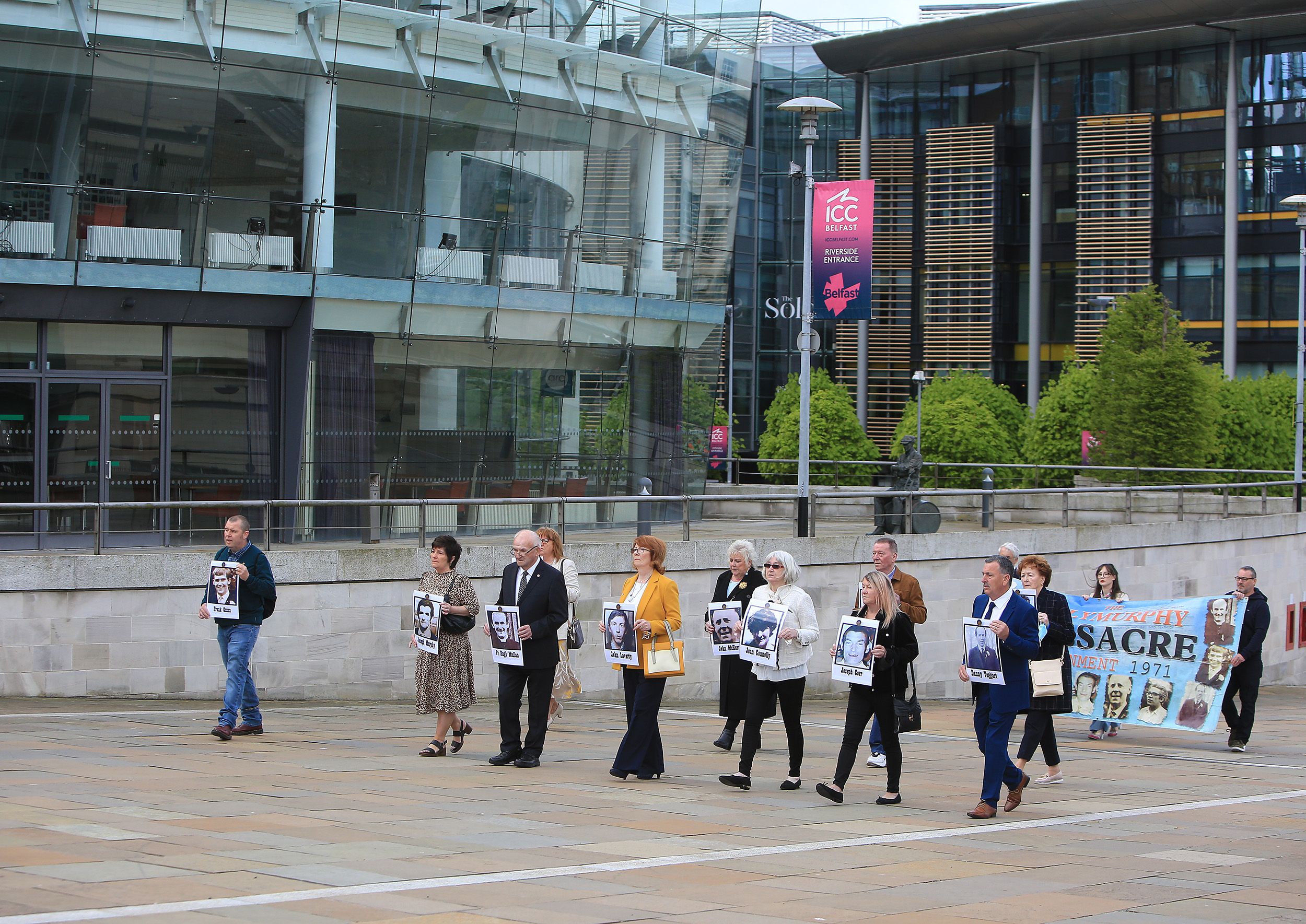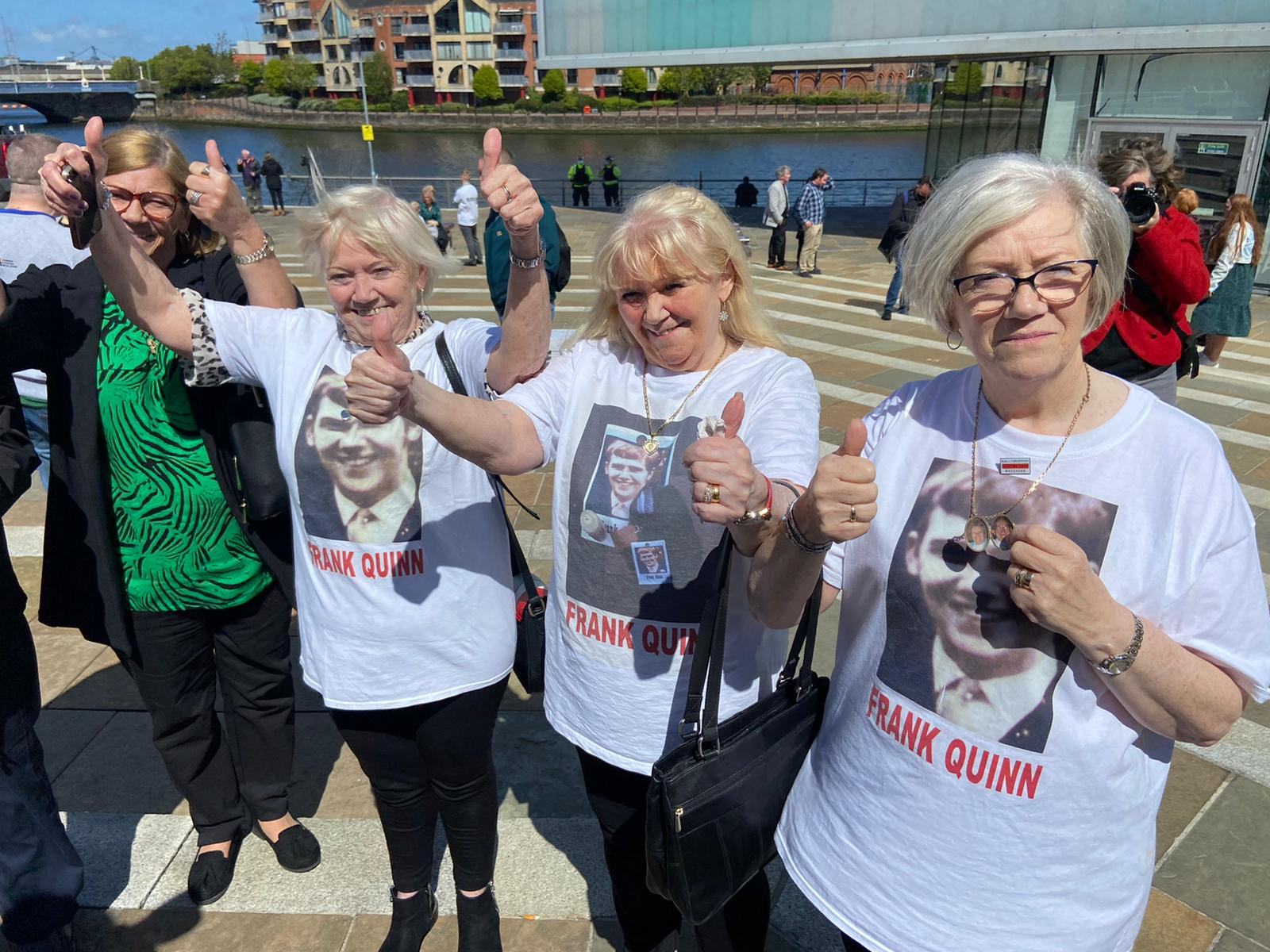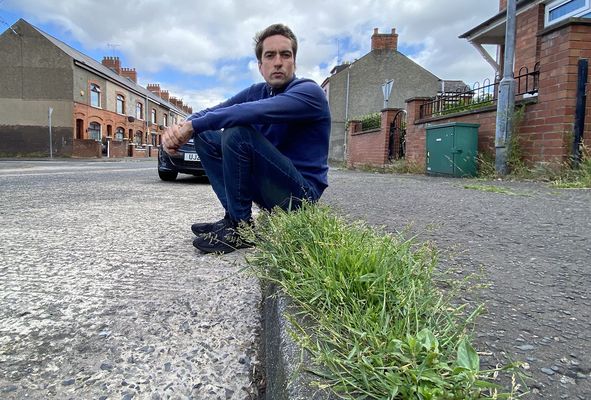ALL TEN people shot dead during the Ballymurphy Massacre were innocent and killed without justification, a coroner has ruled.
Presiding Coroner, Mrs Justice Siobhan Keegan, delivered the inquest findings into the deaths, which occurred during 36-hour period in August in 1971.
The killings took place as the British Army’s notorious Parachute Regiment entered the West Belfast estate in the wake of the introduction of internment.
Justice Keegan noted that the civilian reaction to internment – known as Operation Demetrius – had manifested itself in "disorder" in Ballymurphy and across the North. However, she found that the British Army had used "unjustifiable" and "disproportionate" force in its shooting nine of the innocent victims, who were not involved in the violence.
The coroner found that the state's "shocking" failure to investigate the death of a further innocent victim, who was "indiscriminately shot", meant "there is no direct evidence" to determine who fired the fatal shot.
The Ballymurphy Massacre (9–11 August 1971) was a series of incidents that resulted in the deaths of eleven civilians in total. For the purposes of the inquest, the corner examined five of the incidents.
The new inquest got underway in November 2018 and final oral evidence was heard in March 2020.
Delivering her findings at the International Convention Centre Nightingale Court in Belfast, Justice Keegan said the inquest was the longest-running in the North to date, with 100 court sitting days and "thousands of pages" of evidence.
The Coroner heard oral evidence from civilian, military, expert and other witnesses, and received a large volume of written material in evidence in determining the events in question.
The first shooting incident on August 9 resulted in the deaths of Father Hugh Mullan and Francis Quinn on waste ground that lay between Springfield Park and Moyard Park.
In her assessment of the evidence, the Justice Keegan described "tension in the area” caused by disturbances that had occurred at the interface between Springfield Park and Springmartin.
TOGETHER: Families greet each other before today's ruling
The court heard how residents, including women and children, had attempted to flee the area across the waste ground to Moyard amidst ongoing gunfire.
In the course of events, Father Mullan had gone to the assistance of a man named Robert Clark who was shot on waste ground – a fact that the Coroner maintained.
The court also heard a summary of evidence that said Mr Quinn was shot while going to the aid of those caught in the crossfire.
The Coroner received evidence suggesting that the UVF had gunmen in the area and raised the possibility that a UVF gunman could have been responsible for some of the deaths at Ballymurphy. However, she found that there was no evidence of value to suggest that this was the case in relation to the death of Father Mullan or Mr Quinn.
In 1972, an examination of the swabs from Francis Quinn’s hands revealed small amounts of lead, which the Department of Industrial and Forensic Science concluded were consistent with Mr Quinn being in close proximity to a discharging weapon. However, ballistics experts in the inquest found that it was not possible to conclude the specific source of the lead particles found on Mr Quinn’s hands.
There were also references to the presence of IRA members in the waste ground where the pair were shot. While Justice Keegan maintained there was a "small presence" of gunmen, she insisted she was "not satisfied" they were in the vicinity of the deceased.
She said she had not heard evidence that "either of these men was acting in a way that would cause someone to fear for themselves or others."
"In any event the use of force in my view was clearly more than was necessary to deal with the risk posed by any gunmen in the field," she stated.
"Even if there was a gunman in the field the use of force was clearly disproportionate given the number of civilians around".
The coroner said that a lack of military witnesses had "hampered” the inquest.
She stated that there was "no direct evidence" that either men were armed and that the state had failed to justify their killings, which violated their right to life under Article 2 of the European Convention on Human Rights.
JOURNEY'S END: The families arrive at the inquest
"I consider that there has been a violation of Article 2 given the manner in which the shooting occurred without minimisation of risk," the Coroner said.
Justice Keegan said she "cannot be anymore precise as to who exactly fired the fatal shots", but ruled that both men were unarmed and innocent.
A second incident considered at inquest involved the shooting of Joan Connolly, Noel Phillips and Daniel Teggart in an area known as “the Manse” that same evening. Joseph Murphy, who was shot in the leg during the attack, died of his injuries on 22 August 1971.
Having considered civilian and military evidence, Justice Keegan ruled that rioting surrounding the events was "containable", and dismissed claims that there had been "sustained shooting" directed at the nearby Henry Taggart military base.
She held that while there was some IRA activity in the area, all three victims were unarmed innocent civilians and that their killings were unjustified.
The Coroner said that she accepted that soldiers were "entitled to protect themselves" from gunmen, but there was "no evidence" that the victims were linked to IRA activity, or that they were "direct proximity" to any such activity.
In her findings, Justice Keegan dismissed earlier evidence of 33 rounds of ammunition alleged to have been found in the pockets of Mr Teggart by British soldiers.
"I'm not satisfied on the balance of probabilities this fact is proven," she said.
"I say this, given the seriousness of the allegation fundamentally I cannot understand why if this were true there was no further examination of the ammunition which would have connected it to Mr Teggart."
The inquest also heard evidence of mistreatment of the victims by the British Army, including a delay in providing medical treatment to Mrs Connolly.
Justice Keegan said there was a "basic inhumanity" to the delay and in the way her body was subsequently transported. She said "swifter medical care would have assisted", but that she could not determine if the delay "contributed as a cause of death".
She also branded the army response to the killings in Henry Teggart hall as “insensitive".
The Coroner ruled that the state had contravened its Article 2 obligations, and criticised the British Army for a "clear guidance given to young soldiers" who felt "frightened and under attack".
A third shooting incident resulted in the death of Edward Doherty on the Whiterock Road in the late afternoon of 10 August.
The inquest heard witness statements that described a British Army digger attempting to remove a barricade in the area, with a crowd of persons on the other side of the barricade responding by throwing stones. One described a petrol bomb being thrown towards and into the barricade.
A live military witness, referred to as ‘M3’, the driver of the Army digger, accepted he had fired the shot that killed Mr Doherty.
Justice Keegan said that while she "cannot accept" that the soldier fired indiscriminately as "there would have been greater injury". However, she ruled he had "probably fired a number of rounds at the barricade".
"I can accept that M3 fired in response to being confronted by a petrol bomber and that Mr Doherty may have been in the line of fire," she stated.
“However, as I have said I do not accept that M3 fired a single shot, so I am satisfied that the use of force by M3 was disproportionate."
She added that Mr Doherty "was an innocent man who posed no threat", and that he was not involved in any activity.
In the early hours of 11 August, Joseph Corr and John Laverty were shot at another location in the Whiterock Road area. Mr Corr died of his injuries on 27 August that year.
No civilian or military witnesses were identified who were able to provide evidence of the actual circumstances in which the pair were shot. However, the inquest heard from 15 military witnesses, and a 1972 inquest statement recorded from an unidentified soldier, known as “Soldier B”, was also read into evidence. The statement described engaging two gunmen, one armed with a machine gun, the other a pistol. Soldier B said that he fired six shots wounding at least one gunman.
Justice Keegan ruled that it was “wrong to describe” Mr Corr and Mr Laverty as gunmen, and that that “rumour should be dispelled".
She found that both men “were clearly both shot in the back while either crouching, crawling or prone” and that there was “no evidence that guns were found on or near” the pair.
The Coroner ruled that, since both victims were found to have been shot and killed by the army, “it is for the state through the inquest process to justify the use of lethal force in the circumstances”, adding that she was not satisfied it had not done so.
She further ruled that while there was “shooting in the general area”, it was “not enough of itself to explain the death of civilians on the street”.
The fifth and final incident included in the inquest was the shooting of John McKerr on Westrock Drive on 11 August 1971. Mr McKerr died of his injuries on 20th August 1971.
Justice Keegan stated that she had “no hesitation” in stating that Mr McKerr was an “entirely innocent man who was indiscriminately shot in the street”.
She dismissed claims that Mr McKerr, who was a British Army veteran, was a gunman, adding that he had “no association” with the IRA.
The Coroner said she had “no evidence” to determine who fired the fatal shot, and was “severely hampered by the inadequacy of the investigation of the time”.
A lack of proper investigation, including a failure to interview military personnel was a “core finding” of the inquest.
“That finding is in itself a serious indictment of the state’s failure to properly investigate the death of an innocent civilian,” Justice Keegan concluded.
In her closing remarks, Justice Keegan stated all of the deceased were “entirely innocent of any wrongdoing”, adding that she hoped “some peace may now be achieved” following the findings.
The death of Paddy McCarthy, who died of a heart attack after being harassed and beaten by British soldiers on foot patrol, was not included in the inquest.
The Ballymurphy Families have said they will “continue to campaign for truth and justice for Paddy and his family.”








